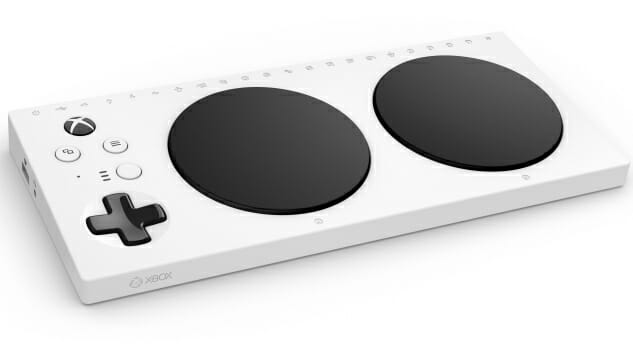
As a conversation about accessibility in videogames rages on in the greater gaming community, behind the scenes, major companies like Microsoft are quietly working to do their part. Nowhere is this more evident than with Microsoft’s new product, the Xbox Adaptive Controller. This year at E3, I got a chance to sit down and talk with Microsoft’s Senior Inclusive Designer Bryce Johnson and Learning Specialist Solomon Romney to learn more about this remarkable device.
Originally conceived of during a hackathon, the adaptive controller has been designed around consumer feedback from the very beginning, an unusual step for Microsoft. In the course of development they worked with The AbleGamers Charity, The Cerebral Palsy Foundation, SpecialEffect, Warfighter Engaged, and Craig Hospital, among others, key contributors who gave feedback to help refine and hone the controller into its most accessible form.
Microsoft’s company vision, as it was explained to me, is to help the people of the world live their best lives. It was this philosophy that led to the realization that if the world’s disabled gamers, a population of 1.2 million, were not being served, then they’ve failed to complete their mission.
This thoughtfulness shows in every aspect of the design. It’s light, the buttons are easy to press, and the edges are rounded to prevent wear and tear on the limbs. The two large black circles in the center of the pad act as the analog sticks, with a wide range of pressure and movement able to create a response. And it sits up on a slight slant (an innovation they observed among caregivers using the device) so that the user’s hands or wrists can rest comfortably.
The adaptive controller, true to its name, is designed to work not as a primary piece of equipment, but rather, to act as a supplement in tandem with Xbox controllers, so those who have figured out alternate means of using them (for example, steering the analog with your chin) will still be able to do so. In the back there is a panel with several ports, each representing a button on an Xbox handheld controller, and by plugging the cord into that specific port, you can essentially remap the buttons, or attach your own peripheral, like a joystick, to a portion of the adaptive controller. It doesn’t just work for one controller, either; if you require two handheld controllers, you can use the adaptive controller to enter a copilot mode that combines both into a one player experience. There are also three player profiles that can be used to program configurations, and these can be used to cement your button scheme to a particular game and switch as needed.
In terms of affordability, Johnson tells me that while price was a consideration in the process, they also wanted to make a controller that was high quality and had value to the users. The price, at $100, isn’t terribly expensive, especially compared to other accessories (for example, the floor button Romney used to accelerate his car in a Forza demo was $80). However I wonder how significant of an accessibility barrier that price may still be.
It was hard to hold back the tears as I spoke to the team about the thought process behind the controller. I’m so used to adapting to a world that’s not built to accommodate me that I barely know what it’s like to have my needs taken into consideration from the conception stage. This is an item that could actually affect and improve the quality of my life. I suspect that those with other physical setbacks, like repetitive stress injuries, may also find value in the adaptive controller. I look forward to using it.
Holly Green is the assistant editor of Paste Games and a reporter and semiprofessional photographer. She is also the author of Fry Scores: An Unofficial Guide To Video Game Grub. You can find her work at Gamasutra, Polygon, Unwinnable, and other videogame news publications.